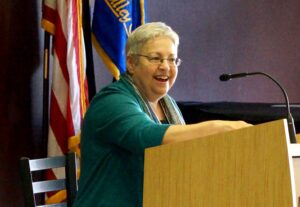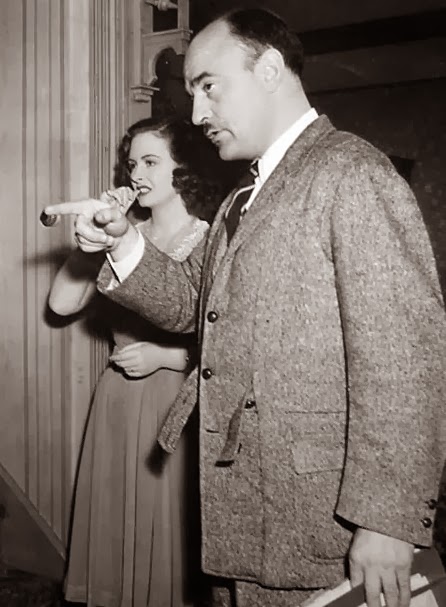By Debbie Burke
Everyone in the writing community is part of a long continuum climbing a steep hill. Those who are ahead often reach down their hands to help those who are less experienced.
For three decades, my local writing group, the Authors of the Flathead (AOF), has thrived because of mentors who extended their hands to the rest of us, freely and generously sharing knowledge.

Barbara Schiffman, script consultant and creative producer
One of those mentors is Barbara Schiffman, who worked in Hollywood for 35+ years as a script consultant and creative producer. She reviewed potential projects for literary agencies and production companies like DreamWorks, HBO, Showtime, and more. After retirement, she and her author-husband Glenn moved to Montana in 2019 to live near their grandchildren and settled into a new home.
Before their boxes were unpacked, Barbara jumped in to help local writers. At the community college in Kalispell, she now facilitates monthly seminars about screenwriting sponsored by AOF and her MT Screenwriting Meetup (https://meetup.com/MTScreenwriting/ – not limited to Montana writers).
At a recent meeting I attended, screenwriters had driven long distances from Polson (50 miles), Ovando (120 miles), Helena (220 miles), and Spokane, Washington (240 miles) to hear Barbara. With gas at more than $5/gallon, these are serious writers hungry to learn. The trip is worth it.
That evening, Barbara spoke about how to make a good first impression on people who might buy your stories. She stresses you never have a second chance to make a good first impression: “Get ’em in the beginning or you don’t get ’em.”
Her approach is two-pronged and applies to both to you as the author and to the main characters of your stories.
You, the writer, could be pitching to agents, editors, producers, etc., hoping to stand out among thousands of writers they meet.
Or…
Your book’s main character could be pitching to readers browsing thousands of books on virtual and physical shelves.
Both you as the author and your main character have the same goal: seduce the reader into saying, “I’ve got to hear/read more about this person!”
Barbara analyzed countless scripts and learned to read quickly, sometimes simultaneously writing a logline, one or two page synopsis, and comments for her clients.
The first 10 pages make or break a screenplay. Even when they didn’t grab her, she still needed to skim the rest, write a full summary, and make recommendations. The options were pass or consider, strong consider, or consider with recommendations.
An unqualified Recommend was rare. While many scripts were good, they needed to be great to earn a Recommend.
Insider tip: a reader’s analysis of each script or book must be thoroughly documented, including the date received and who submitted it, to protect the producer, director, and others from plagiarism claims.
Next, Barbara put us through an exercise to demonstrate everyone has a unique quality or experience that makes them memorable. She asked each person to give their name, where they’re from, and relate one unusual thing about themselves that isn’t generally known.
She offered her own example of a memorable event that led to a realization: a fire walk with motivational guru Tony Robbins. As she walked across the coals, she thought, This isn’t so hot. Yet afterward, she had a blister on her little toe. Even though her perception had been the walk was no big deal, the physical blister proved to her that, yes, the fire was indeed scorching.
Then she went around the room full of writers, ranging in age from early 20s to 70+, asking for their memorable events. Since I don’t have their permission, I can’t share what they said. But every single person, no matter how ordinary they appeared, had a unique, surprising story that caused the rest of us to say Wow!
Prior to that evening, I hadn’t met several newcomers. Next time I see them, I likely won’t remember their names or where they’re from but I will definitely remember the unique story they told.
That is exactly the effect a writer wants to achieve when meeting with a producer, actor, agent, or editor. According to Barbara, even if they don’t accept your current pitch, if you make a good impression, they will remember you and perhaps offer a different opportunity later.
Your main character must make a similar impact when s/he first walks onstage in the story.
If it’s a script, you want the actor reading it to say, “I have to play that character onscreen.”
If it’s a novel, you want the reader to say, “I have to learn more about this character. I need to buy this book.”
A current character description trend in screenwriting is to be minimalist—hair color, height, age. Barbara considers that “lazy writing.” When she reads scripts, she wants to know more than surface impressions. She says physical traits are important ONLY if they are integral to the plot.
“Less can be more but make it the right less,” she says.
Barbara recommends developing a skill she calls “screenplay haiku”—memorable phrases, especially in dialogue, that she says may wind up in a movie trailer and frequently in common lexicon.
Think: Make my day. (Clint Eastwood, Dirty Harry).
Houston, we’ve had a problem. (Jim Lovell, Apollo 13)
I’ll be back. (Arnold Schwarzenegger, Terminator)
Barbara admires Taylor Sheridan, the creator-producer of Yellowstone and considers him “Shakespeare in the Wild West.”
She also mentioned Sheridan’s screenplay of Hell or High Water as a prime example of memorable screenwriting. A number of TKZers have recommended the film. Here’s a scene-by-scene dissection by director David Mackenzie.
Timothy Hallinan’s Junior Bender book series has also earned Barbara’s admiration. She says he’s a cross between Carl Hiaasen and Donald Westlake.
From Crashed: A Junior Bender Mystery, here’s Hallinan’s first description of a dirty cop named Hacker:
The face in the rear-view mirror possessed more distinctive characteristics than you’d normally find in a whole room full of faces. The eyes, black as a curse, were so close to each other they nearly touched, barely bisected by the tiniest nose ever to adorn an adult male face. I’d seen bigger noses on a pizza. The guy had no eyebrows and a mouth that looked like it was assembled in the dark: no upper lip to speak of, and a lower that plumped out like a throw pillow, above a chin as sharp as an elbow.
It wasn’t a nice face, but that was misleading. The man who owned it wasn’t just not nice: he was a venal, calculating, corrupt son of a bitch.
That’s a character most readers will remember!
~~~
Thanks, Barbara, for sharing tips on how to make a memorable first impression.
For more info about her, visit: https://literasee.com/
Check out: https://www.meetup.com/mtscreenwriting/
~~~
My memorable detail for today is I’m having cataract surgery. Barbara kindly offered to pinch-hit and respond to comments, as well as answer questions.
~~~
TKZers: What makes your main character memorable?
If you dare, share a memorable detail about yourself.


